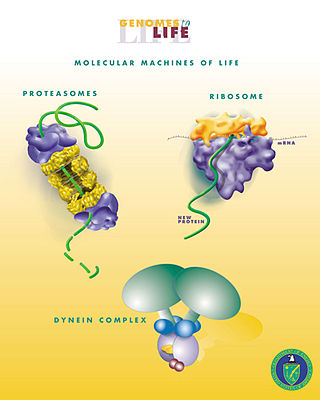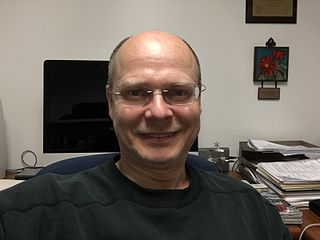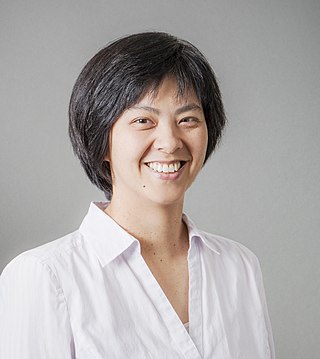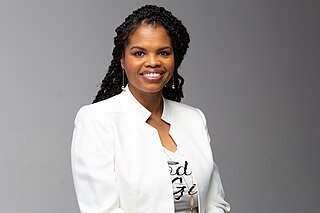Related Research Articles

Whiskers or vibrissae are a type of stiff, functional hair used by most mammals to sense their environment. These hairs are finely specialised for this purpose, whereas other types of hair are coarser as tactile sensors. Although whiskers are specifically those found around the face, vibrissae are known to grow in clusters at various places around the body. Most mammals have them, including all non-human primates and especially nocturnal mammals.
Biorobotics is an interdisciplinary science that combines the fields of biomedical engineering, cybernetics, and robotics to develop new technologies that integrate biology with mechanical systems to develop more efficient communication, alter genetic information, and create machines that imitate biological systems.

The barrel cortex is a region of the somatosensory cortex that is identifiable in some species of rodents and species of at least two other orders and contains the barrel field. The 'barrels' of the barrel field are regions within cortical layer IV that are visibly darker when stained to reveal the presence of cytochrome c oxidase and are separated from each other by lighter areas called septa. These dark-staining regions are a major target for somatosensory inputs from the thalamus, and each barrel corresponds to a region of the body. Due to this distinctive cellular structure, organisation, and functional significance, the barrel cortex is a useful tool to understand cortical processing and has played an important role in neuroscience. The majority of what is known about corticothalamic processing comes from studying the barrel cortex, and researchers have intensively studied the barrel cortex as a model of neocortical column.

Biological engineering or bioengineering is the application of principles of biology and the tools of engineering to create usable, tangible, economically viable products. Biological engineering employs knowledge and expertise from a number of pure and applied sciences, such as mass and heat transfer, kinetics, biocatalysts, biomechanics, bioinformatics, separation and purification processes, bioreactor design, surface science, fluid mechanics, thermodynamics, and polymer science. It is used in the design of medical devices, diagnostic equipment, biocompatible materials, renewable energy, ecological engineering, agricultural engineering, process engineering and catalysis, and other areas that improve the living standards of societies.

The American Institute for Medical and Biological Engineering (AIMBE) is a non-profit organization founded in 1991, and headquartered in Washington. It represents 50,000 medical and biomedical engineers, and academic institutions, private industry, and professional engineering societies.
Shana O. Kelley is a scientist and Neena B. Schwartz Professor of Chemistry and Biomedical Engineering at Northwestern University. She is affiliated with Northwestern's International Institute for Nanotechnology and was previously part of the University of Toronto's Faculty of Pharmacy and Faculty of Medicine. Kelley's research includes the development of new technologies for clinical diagnostics and drug delivery. In 2023, she was chosen as president of Chicago's new Chan Zuckerberg Biohub.

Ravi V. Bellamkonda is an Indian-American biomedical engineer and academic administrator. Since 2021, he has served as Provost and Executive Vice President for Academic Affairs at Emory University in Atlanta, Georgia. Bellamkonda was previously Vinik Dean of the Pratt School of Engineering at Duke University.

Wolfgang Fink is a German-American theoretical physicist. He is currently an associate professor and the inaugural Maria & Edward Keonjian Endowed Chair of Microelectronics at the University of Arizona. Fink has joint appointments in the Departments of Electrical & Computer Engineering, Biomedical Engineering, Systems & Industrial Engineering, Aerospace & Mechanical Engineering, and Ophthalmology & Vision Science at the University of Arizona. He is the current Vice President of the Prognostics and Health Management (PHM) Society.

Ellis Meng is the Shelly and Ofer Nemirovsky Chair of Convergent Biosciences and Professor of Biomedical Engineering and Electrical and Computer Engineering in the Viterbi School of Engineering at the University of Southern California, where she also serves as the Vice Dean of Technology Innovation and Entrepreneurship. Meng is highly decorated in the development of novel micro- and nanotechnologies for biomedical applications. In 2009, Meng was named on MIT Technology Review's "Innovators Under 35" List for her work on micropumps that deliver drugs preventing blindness, and she was listed on the 40 Under 40 List of the Medical Device and Diagnostic Industry (MDDI) in 2012.
Guillermo Antonio Ameer is the Daniel Hale Williams Professor of biomedical engineering at the Robert R. McCormick School of Engineering and Applied Science and Surgery at the Feinberg School of Medicine of Northwestern University and is a fellow of the American Institute for Medical and Biological Engineering, Biomedical Engineering Society, American Institute of Chemical Engineers, American Association for the Advancement of Science, Materials Research Society, and American Academy of Arts and Sciences. He is an engineer, inventor, and entrepreneur.
Philip LeDuc is the William J. Brown Professor at Carnegie Mellon University (CMU) and the Founding Director of its Center for the Mechanics and Engineering of Cellular Systems. He is in the department of Mechanical Engineering, but also has appointments in Biological Sciences, Computational Biology, Biomedical Engineering, and Electrical and Computer Engineering. LeDuc works at the intersection of mechanical engineering and biology.
Emily S. Day is an American biomedical engineer. She is an associate professor at the University of Delaware where her research team engineers nanoparticles to enable high precision therapy of diseases including cancers, blood disorders, and maternal/fetal health complications.

Lakiesha Williams is a biomedical engineer and an Associate Professor at the University of Florida. Williams specializes in traumatic brain injury and biomechanics. Specifically, her work involves the modelling and mechanics of soft tissue, and how outside influences affect their structure. Much of her work on repetitive brain trauma involves utilizing preclinical models to study the long term neurodegenerative effects of damages. She grew up in New Orleans, with her dad working as a carpenter. Williams went on to become a first generation college student, college graduate, and now, an Associate Professor.
Beth L. Pruitt is an American engineer. Upon completing her master's degree in manufacturing systems engineering from Stanford University, Pruitt served as an officer in the United States Navy. She is a full professor of mechanical engineering, biological engineering, and biomolecular science & engineering at the University of California, Santa Barbara. She is a fellow of both ASME and AIMBE.
Vadim Backman is an American biomedical engineer and the Sachs Family Professor of biomedical engineering at the Robert R. McCormick School of Engineering and Applied Science at Northwestern University. He is also a Professor of Medicine (Hematology/Oncology) and Professor of Biochemistry and Molecular Genetics at Feinberg School of Medicine and is the Associate Director of Research Technology and Infrastructure and Program Leader in Cancer and Physical Sciences at Robert H. Lurie Comprehensive Cancer Center.
Marcia Kilchenman O'Malley is an American mechanical engineer, the Thomas Michael Panos Family Professor in Mechanical Engineering and associate dean for research and innovation for the George R. Brown School of Engineering at Rice University. Her research concerns "systems for enhancing the human sensorimotor control system", including work on exoskeletons, neuroprosthetics, haptic technology, and brain–computer interfaces.
Catherine M. Klapperich is an American biomedical engineer noted for her research on diagnostics and precision medicine. She is currently professor of biomedical engineering at Boston University, with additional appointments in materials science & engineering and mechanical engineering. Klapperich serves as the director of research for the DAMP Laboratory at BU. Klapperich was previously the director of the NIH NIBIB Center for Future Technologies in Cancer Care as part of the Point-of Care-Research Technologies Network.
Anna Devor אנה דבור (Hebrew) is an Israeli-American biomedical engineer who is a full professor at Boston University. Her research considers neuronal imaging and new strategies to better understand brain function. She is the editor of Neurophotonics, an SPIE journal.
Dawn M. Elliott is an American biomedical engineer whose research concerns the biomechanics of connective tissue including the tendons, menisci, and intervertebral discs. She is Blue and Gold Distinguished Professor of Biomedical Engineering at the University of Delaware, adjunct professor of orthopaedic surgery at the Perelman School of Medicine at the University of Pennsylvania, and the former president of the Biomedical Engineering Society.
Claudia Fischbach is a German bioengineer who is the Stanley Bryer 1946 Professor of Biomedical Engineering at Cornell University. She is Director of the Cornell Physical Sciences Oncology Center on the Physics of Cancer Metabolism.
References
- ↑ Simon, Matt. "Want a Robot That Can Really Feel? Give It Whiskers", Wired , 14 July 2017. Retrieved on 13 June 2021.
- ↑ Northwestern University Master of Science in Robotics. "Five Minutes With Professor Mitra Hartmann", Northwestern University, 9 October 2018. Retrieved on 13 June 2021.
- ↑ Krisch, Joshua A. "E-Whiskers Have Arrived to Fulfill All Your Robot Cat Dreams", Popular Mechanics , 20 January 2014. Retrieved on 13 June 2021.
- ↑ Morris, Amanda. "Rat Whiskers Shed Light on How Neurons Communicate Touch", Northwestern University, 2 August 2016. Retrieved on 13 June 2021.
- ↑ Nield, David. "A Genius New Simulation Has Revealed More on How Whiskers Actually Work", ScienceAlert , 10 April 2021. Retrieved on 13 June 2021.
- ↑ PLOS. "First-of-its-kind mechanical model simulates bending of mammalian whiskers", ScienceDaily , n.d. Retrieved on 13 June 2021.
- ↑ VideoLectures.net. "Mitra Hartmann", Videolectures.net, n.d. Retrieved on 13 June 2021.
- ↑ Morris, Amanda. "Five Faculty Members Elected to Medical and Biological Engineering Elite ", Northwestern University, 16 February 2017. Retrieved on 13 June 2021.
- ↑ American Institute for Medical and Biological Engineering (AIMBE). "Mitra J. Hartmann, Ph.D. To be Inducted into Medical and Biological Engineering Elite", AIMBE, 7 March 2017. Retrieved on 13 June 2021.
- ↑ "Sensory and Neural Systems Engineering", Northwestern University, 2012. Retrieved on 13 June 2021.
- ↑ Northwestern University. "Mitra Hartmann", Northwestern University, n.d.. Retrieved on 13 June 2021.